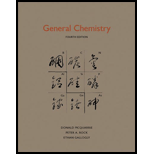
Concept explainers
Interpretation:
Partial pressure of
Concept Introduction:
The combination of all the
Here,
The net pressure for gaseous mixture is equal to algebraic sum of partial pressures of its constituent gases. This is referred as Dalton’s law.
For a mixture of two gases, 1 and 2,
In terms of mole fraction the partial pressure is calculated as follows:
Here,
Answer to Problem 13.37P
The partial pressure of
Explanation of Solution
Assume the temperature is
The formula to convert degree Celsius to kelvin is as follows:
Substitute
The expression to calculate
Substitute
Substitute
Substitute
The formula of total moles in mixture is given as follows:
Substitute
The formula to calculate mole fraction is as follows:
Here,
Substitute
Similarly, substitute
Likewise,
The expression to calculate pressure as per the ideal gas equation is as follows:
Substitute
In terms of mole fraction the partial pressure is calculated as follows:
Here,
Substitute 0.0714285for
In terms of mole fraction the partial pressure is calculated as follows:
Here,
Substitute 0.8571428 for
Partial pressure of
Here,
Substitute 0.0714285 for
For given mixture of gases
Substitute
Want to see more full solutions like this?
Chapter 13 Solutions
General Chemistry
 ChemistryChemistryISBN:9781305957404Author:Steven S. Zumdahl, Susan A. Zumdahl, Donald J. DeCostePublisher:Cengage Learning
ChemistryChemistryISBN:9781305957404Author:Steven S. Zumdahl, Susan A. Zumdahl, Donald J. DeCostePublisher:Cengage Learning ChemistryChemistryISBN:9781259911156Author:Raymond Chang Dr., Jason Overby ProfessorPublisher:McGraw-Hill Education
ChemistryChemistryISBN:9781259911156Author:Raymond Chang Dr., Jason Overby ProfessorPublisher:McGraw-Hill Education Principles of Instrumental AnalysisChemistryISBN:9781305577213Author:Douglas A. Skoog, F. James Holler, Stanley R. CrouchPublisher:Cengage Learning
Principles of Instrumental AnalysisChemistryISBN:9781305577213Author:Douglas A. Skoog, F. James Holler, Stanley R. CrouchPublisher:Cengage Learning Organic ChemistryChemistryISBN:9780078021558Author:Janice Gorzynski Smith Dr.Publisher:McGraw-Hill Education
Organic ChemistryChemistryISBN:9780078021558Author:Janice Gorzynski Smith Dr.Publisher:McGraw-Hill Education Chemistry: Principles and ReactionsChemistryISBN:9781305079373Author:William L. Masterton, Cecile N. HurleyPublisher:Cengage Learning
Chemistry: Principles and ReactionsChemistryISBN:9781305079373Author:William L. Masterton, Cecile N. HurleyPublisher:Cengage Learning Elementary Principles of Chemical Processes, Bind...ChemistryISBN:9781118431221Author:Richard M. Felder, Ronald W. Rousseau, Lisa G. BullardPublisher:WILEY
Elementary Principles of Chemical Processes, Bind...ChemistryISBN:9781118431221Author:Richard M. Felder, Ronald W. Rousseau, Lisa G. BullardPublisher:WILEY





